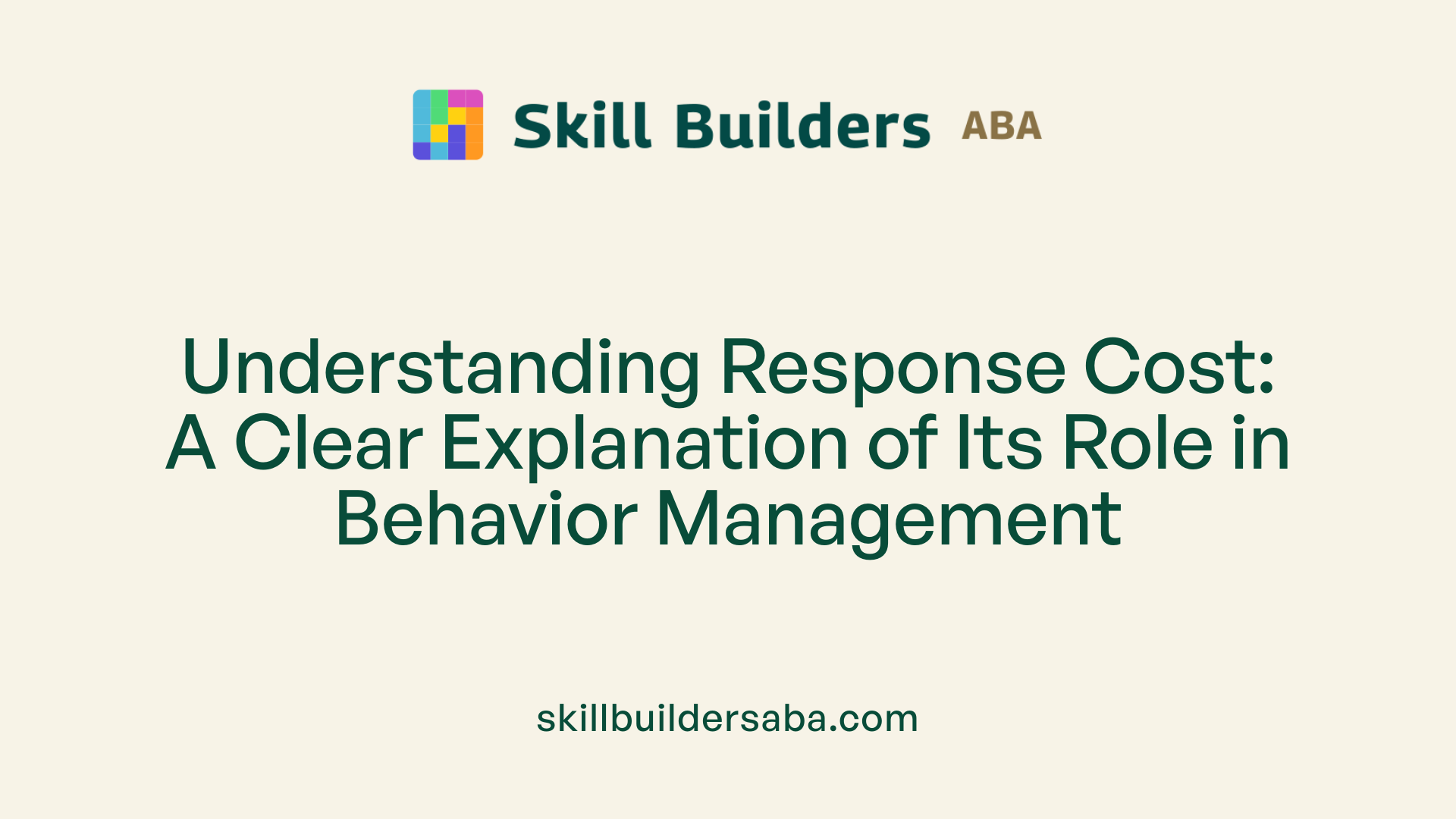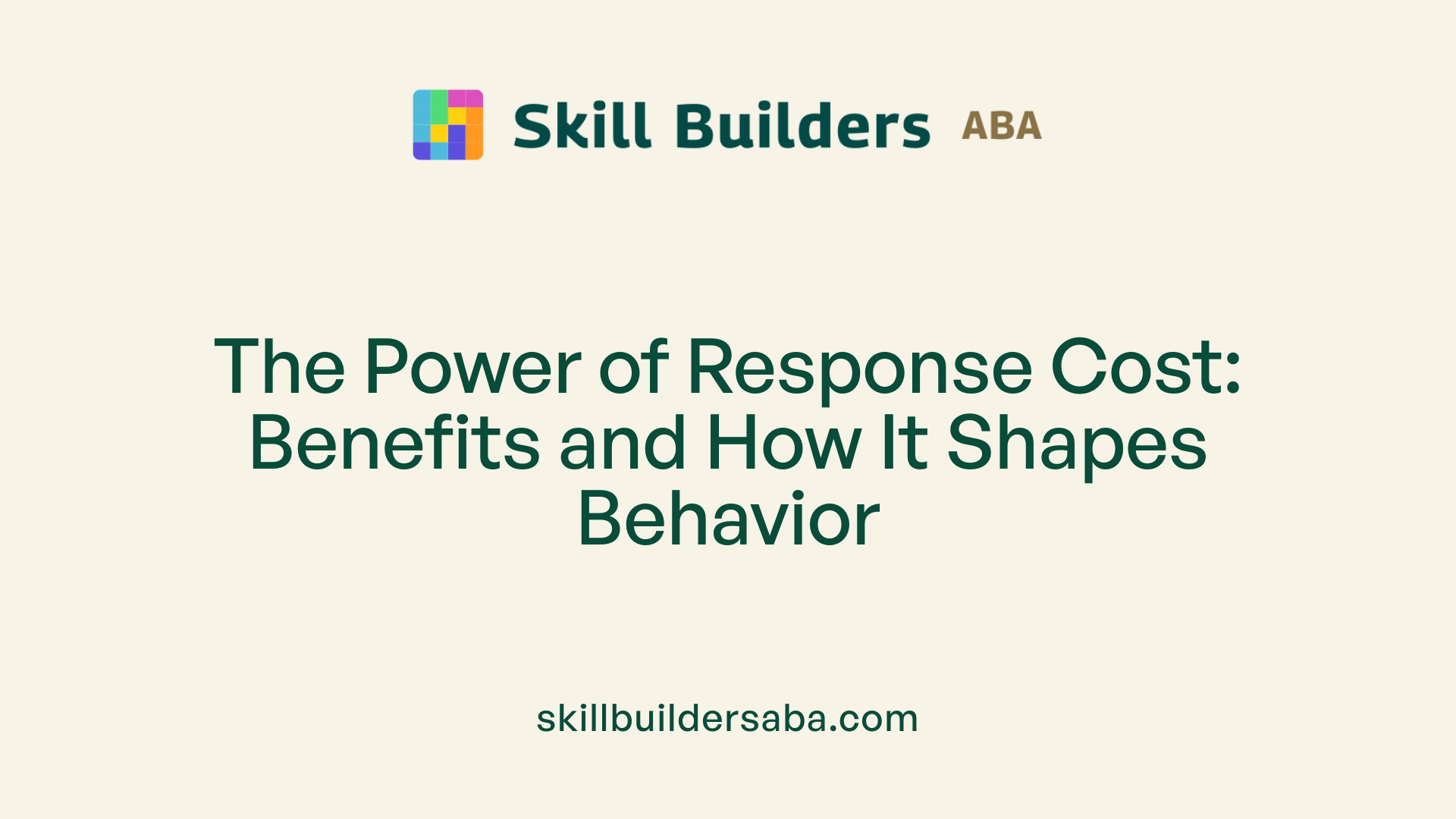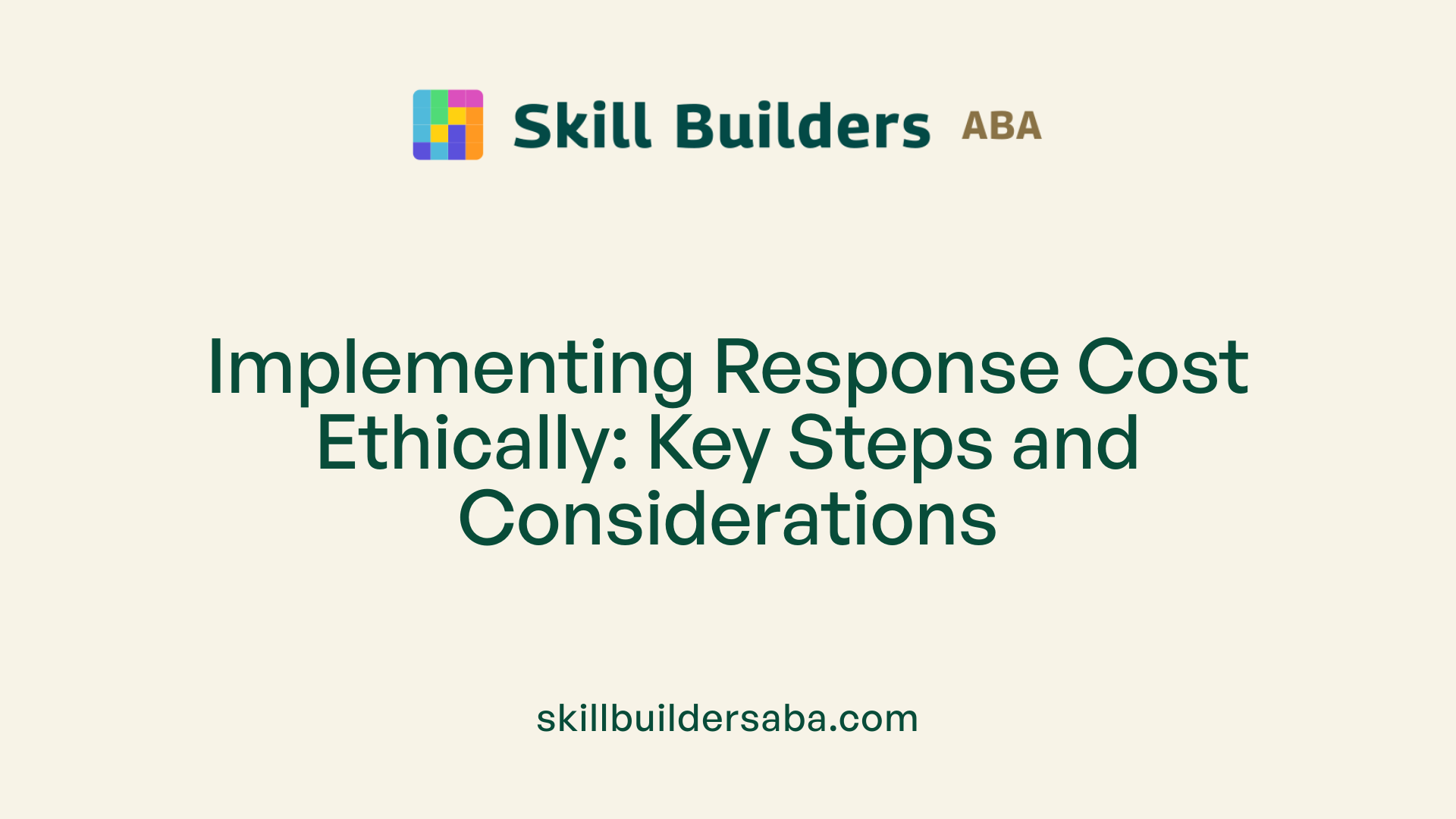
What is response cost and when is it used
Understanding Response Cost in Behavioral Intervention
Introduction to Response Cost
Response cost is a fundamental concept in applied behavior analysis (ABA) and behavior therapy, serving as an effective technique to reduce maladaptive behaviors. Recognized as a form of negative punishment, response cost involves the removal of a valued stimulus, such as tokens, privileges, or possessions, immediately following undesirable behavior. Its strategic application within reinforcement systems like token economies has shown promising results across diverse populations, including children with autism, individuals with behavioral disorders, and adults in clinical settings. This article explores the nature of response cost, its applications, how it compares with other interventions, and guidelines for effective implementation.
Definition and Nature of Response Cost

What response cost involves
Response cost is a behavioral technique used to reduce undesirable actions by removing a positive reinforcer or privilege following the targeted behavior. This removal can be a tangible item, such as tokens, points, or possessions, or even privileges like free time or access to preferred activities. Typically, the response cost is implemented immediately after the behavior occurs, making the consequence clear and direct.
How response cost functions as a punishment methodology
In practice, response cost is a form of negative punishment, meaning it decreases the likelihood of a behavior by taking away something valuable. It is often integrated into token economy systems, where tokens represent reinforcers. When a problematic behavior is observed, a specific number of tokens or points are deducted, which discourages the behavior over time. Research has demonstrated the effectiveness of response cost in suppressing behaviors such as smoking, overeating, stuttering, and even psychotic talk.
Its role within the framework of ABA and behavior therapy
Within Applied Behavior Analysis (ABA) and broader behavior therapy, response cost serves as a strategic tool to modify behavior. It is used both as a standalone punishment and as part of comprehensive reinforcement programs that include positive reinforcement. When combined with reward-based strategies, response cost balances reinforcement and punishment, helping to promote skill development and discourage maladaptive actions.
Moreover, proper implementation of response cost involves planning ahead, clearly defining which behaviors will result in token loss, and communicating these rules effectively. Ensuring tokens are removed calmly and immediately after the behavior, without emotional reactions, supports ethical use and enhances effectiveness.
Research supports its use across various populations, including children with ADHD, autism spectrum disorder, and other behavioral challenges. It tends to produce durable behavior change with fewer adverse side effects than other punitive measures, making it a preferred choice within ABA frameworks for reducing challenging behaviors.
Application Scenarios and Effectiveness of Response Cost
 Response cost is a widely used technique in behavior management that involves removing a reinforcing stimulus following problematic behavior to reduce its occurrence. This approach is especially effective when integrated into structured systems like token economies, where tokens, points, or privileges act as conditioned reinforcers.
Response cost is a widely used technique in behavior management that involves removing a reinforcing stimulus following problematic behavior to reduce its occurrence. This approach is especially effective when integrated into structured systems like token economies, where tokens, points, or privileges act as conditioned reinforcers.
When is response cost utilized? It is typically implemented when a child's behavior is disruptive or undesirable, such as in classroom settings or therapy environments. For example, a student earning tokens for positive behaviors might lose a certain number of tokens if they engage in disruptive acts like talking out of turn or leaving their seat without permission. In therapy for children with autism, response cost can be used to decrease behaviors like stimming or self-injury by removing preferred items or privileges whenever such behaviors happen.
Where is response cost applied? This technique is mostly used in educational and clinical environments, including schools, therapy clinics, and at home. It is often part of a broader reinforcement system, especially in applied behavior analysis (ABA) programs. For example, teachers and therapists may use token systems where each unwanted behavior results in the removal of a token or privilege. It is also effective for managing behaviors in populations with autism, attention-deficit/hyperactivity disorder (ADHD), or disruptive tendencies.
What types of behaviors are targeted? Response cost aims at reducing behaviors that hinder learning or pose safety risks. Common targets include disruptive classroom behaviors, tantrums, non-compliance, and other maladaptive actions. It can be used to address smoking, overeating, stuttering, or psychotic talk, demonstrating its versatility across different contexts.
An example of response cost in practice involves a student earning tokens for good classroom behavior, with tokens being deducted when disruptive or unsafe behaviors occur. For instance, removing a preferred activity or privilege when a child exhibits aggressive or non-compliant behavior helps reinforce the idea that positive actions lead to rewards, while negative behaviors lead to consequences.
Overall, response cost is most effective when implemented consistently, with clear rules and immediate removal of reinforcers following the targeted behavior. When used appropriately, it can significantly decrease undesirable behaviors without the emotional side effects often associated with punitive measures.
Purpose and Benefits of Using Response Cost

What is the purpose of response cost in behavior management?
Response cost aims to reduce undesirable behaviors by removing a valued reinforcer or privilege immediately after the behavior occurs. This method operates on the principles of operant conditioning, where the withdrawal of a positive stimulus discourages the repetition of the problematic behavior.
In practical settings, response cost is often integrated into token economies. For example, if a student displays disruptive behavior, they might lose tokens that they had previously earned, serving as a tangible reminder that their actions have consequences.
This approach encourages accountability and helps individuals understand that their actions directly impact their privileges or rewards. When implemented ethically, response cost can effectively diminish maladaptive behaviors without the adverse side effects common with other punishment techniques.
The central idea is to connect undesirable behaviors with specific losses, guiding individuals towards more positive and appropriate behaviors through consistent feedback and consequences.
How is response cost advantageous compared to other punishment techniques?
Response cost is often more acceptable and less harmful than traditional punishment procedures like physical punishment or harsh reprimands. Unlike punitive actions that can evoke emotional reactions or resentment, response cost typically involves calm and immediate removal of tokens or privileges.
Research indicates that when the ratio of positive reinforcement outweighs response cost—generally by at least three to one—it remains effective while minimizing negative feelings. This balance helps maintain motivation and fosters a more positive learning environment.
In addition, because response cost is part of a reinforcement system, it emphasizes behavioral improvement rather than just punishment. This shift toward reinforcement promotes sustainable behavioral change, especially when replacement behaviors are positively reinforced.
How does response cost minimize side effects?
Compared to other forms of punishment, response cost rarely results in emotional distress or avoidance behaviors. Since tokens or privileges are removed calmly and immediately after the targeted behavior, it reduces the emotional reaction often associated with punitive punishments.
Furthermore, clear communication about the system and consistent application help individuals understand the consequences without feeling personally attacked or unfairly treated. Not allowing negative balances or excessive losses also prevents discouragement.
Adjustments based on observation and data collection ensure the system remains fair and effective. This proactive approach minimizes the risk of side effects, making response cost a valuable component of behavior management programs, especially within therapy settings like ABA for children with autism.
| Aspect | Details | Benefits |
|---|---|---|
| Usage Context | Therapy, classrooms, home | Flexibility across environments |
| Population | Children with behavior disorders, ADHD, autism | Wide applicability |
| Implementation Considerations | Calm removal, timely feedback, clear rules | Reduces emotional reactions |
| Ratio of Reinforcement to Cost | 3:1 or higher for effectiveness | Maintains motivation |
| Side Effect Risk | Minimal emotional or behavioral backlash | Safer for sensitive populations |
Overall, response cost is a practical and ethically sound way to manage challenging behaviors, supporting positive behavioral change over the long term.
Implementation and Ethical Considerations in Response Cost Usage

Steps for successful implementation
To effectively use response cost in behavior therapy, careful planning is essential. First, identify and define the specific behaviors that will trigger token removal or other forms of response cost. Clear criteria ensure consistency and fairness in application. It's important to prepare these rules ahead of time and communicate them thoroughly to the individual involved.
In practice, tokens or other conditioned reinforcers are earned through positive behaviors. When undesirable behaviors occur, tokens are immediately removed, ideally without emotional reactions, to reinforce the negative consequence. Implementation works best when the amount of reinforcement given outweighs the response cost, often at a ratio of three or more to one.
Communication and rules
Communication plays a vital role in the success of response cost procedures. Students or clients should clearly understand what behaviors lead to token removal and the associated consequences. Using warnings before token deductions can help prepare them for the potential loss, reducing frustration or confusion.
Tokens should be taken away calmly and consistently, ensuring the individual perceives the process as fair. It's also crucial to avoid allowing negative balances, which can undermine the system’s effectiveness.
Monitoring and adjustments
Monitoring behavior and system effectiveness is vital. Regular data collection and observation guide adjustments to the plan if it does not produce the desired results. For example, if behaviors persist or worsen, the amount of response cost might need to be increased, or additional reinforcement strategies might be introduced.
Adjustments should be aimed at maintaining a balance where the negative consequence effectively decreases undesired behaviors without causing undue emotional distress or developing aversions. Continual assessments ensure that response cost remains an ethical, fair, and effective part of a comprehensive behavior management strategy.
Summary and Best Practices for Response Cost
Response cost is a versatile and evidence-based technique within the spectrum of behavior management strategies. Its core principle—removing a valued stimulus following undesirable behavior—serves to reduce maladaptive actions effectively across various settings and populations. Proper implementation requires clear communication, ethical considerations, and consistent application, ideally as part of a comprehensive reinforcement system. When used appropriately, response cost can promote durable behavioral change with fewer side effects compared to other punitive methods, making it a valuable tool for clinicians, educators, and caregivers committed to promoting positive behavior change.
References
- Response cost: The removal of conditioned reinforcers for ...
- DOs and DON'Ts of Using Fines or Response Cost to Reduce ...
- Response Cost | Behavioural therapy | Jewel Autism Centre
- Understanding Response Cost in ABA - Elemy
- Response Cost - SpringerLink
- Response cost: The removal of conditioned reinforcers for ...
- The effects of response cost in the treatment of aberrant behavior ...
- Understanding Response Cost in ABA - Elemy
Reach Out Today
Learn more about how we can support your child’s growth and development. Contact us to discuss our services and availability in your area.
.svg)